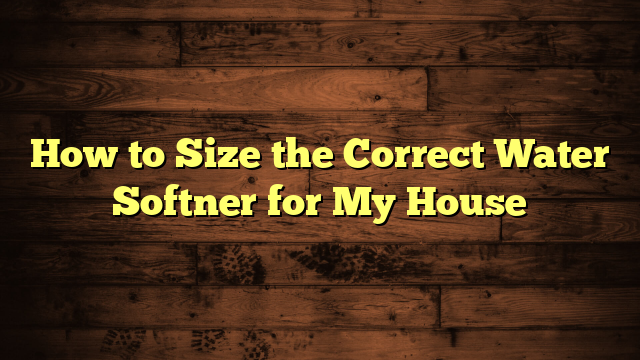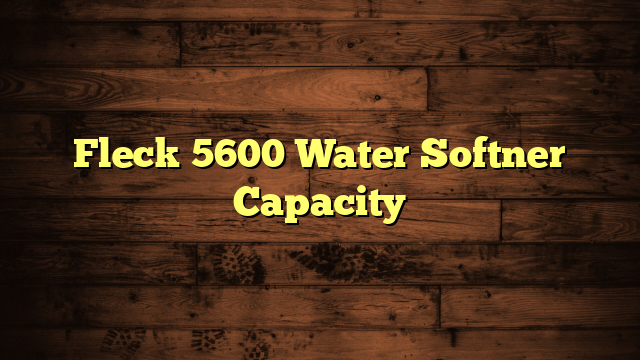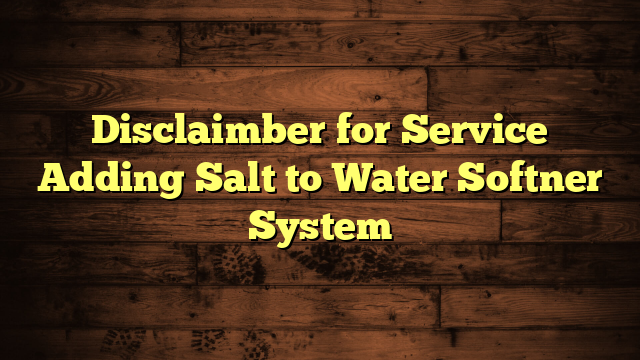How to Size the Correct Water Softner for My House
Choosing the right water softener is like finding the right key for a lock; it opens up the potential for better water quality in your home. You might be wondering how to determine the ideal size that'll meet your household's needs without unnecessary excess. To get started, you'll need to look at water hardness, your family's daily consumption, and more. But before you rush off to make a purchase, there are several factors to evaluate that could make all the difference in your decision.
Key Takeaways
- Determine your water hardness level through testing to understand the mineral concentration in your water supply.
- Calculate your household's daily water usage by multiplying the average usage (80-100 gallons per person) by the number of residents.
- Choose the appropriate water softener type (salt-based, salt-free, or dual-tank) based on your household's needs and maintenance preferences.
- Ensure the salt storage capacity matches your household size and water hardness, typically requiring 200-300 pounds of salt.
- Consider professional installation for optimal setup, or research thoroughly for a successful DIY installation if you choose that route.
Understanding Water Hardness
To get a grasp on sizing a water softener, you first need to understand water hardness. Water hardness is primarily determined by the levels of calcium and magnesium in your water supply. These minerals can notably affect your water quality, leading to scale buildup in pipes and appliances.
So, knowing your water's hardness levels is essential.
To find out how hard your water is, you'll want to conduct hardness testing. You can either use a home testing kit or send a sample to a lab for a more accurate analysis. The results will typically indicate whether your water is soft (0-60 mg/L), moderately hard (61-120 mg/L), hard (121-180 mg/L), or very hard (over 180 mg/L).
Understanding these categories helps you determine the right size of water softener for your needs.
Keep in mind that the hardness of your water can fluctuate based on the source, so regular testing can help you stay informed.
Assessing Household Size
Knowing your water hardness is a great start, but you also need to take into account household size when sizing a water softener.
Your household demographics and family lifestyle considerably influence your softener's capacity requirements. To get the best fit, consider these three key factors:
- Number of Residents: More people typically mean more water usage, so you'll want a softener that can keep up with the demand.
- Daily Activities: Think about your family's lifestyle. Do you have kids who take frequent baths? Do you run multiple loads of laundry daily? These aspects can increase your water needs.
- Appliance Usage: If you have a dishwasher, washing machine, or other water-using appliances, their efficiency often improves with softened water, affecting how much capacity you require.
Calculating Daily Water Usage
Calculating daily water usage is vital for determining the right size of your water softener. To get started, you'll want to perform a daily consumption analysis of your household.
Begin by tracking your water usage over a week or month. This means noting how much water you use for drinking, cooking, bathing, laundry, and outdoor activities.
One effective method for water usage tracking is to monitor your water meter. Check the meter before and after periods of typical water use, then calculate the difference. Alternatively, you can estimate based on average household water usage data. The average person uses about 80-100 gallons of water daily, but this can vary widely based on lifestyle and family size.
Once you've gathered your data, calculate your average daily water usage. Multiply this by the number of people in your home to find your total daily consumption.
This figure is essential, as it helps guarantee your water softener can meet your household's needs efficiently. By understanding your daily water usage, you'll be better prepared to choose a water softener that keeps your home comfortable and your water quality outstanding.
Choosing the Right System Type
When it comes to choosing the right water softener system, you've got a few options to evaluate.
Different types of systems vary in size and installation requirements, so it's important to reflect on what fits your home best.
Types of Water Softeners
Choosing the right type of water softener can make a significant difference in how effectively it addresses hard water issues in your home.
With various options available, you'll want to evaluate your needs, budget, and preferences before making a decision. Here are three common types of water softeners:
1. Traditional Salt-Based Softeners: These systems use sodium ions to replace the calcium and magnesium in hard water.
They're highly effective but require regular maintenance and salt refills.
2. Salt-Free Systems: If you prefer an eco-friendly option, Salt-Free Systems don't remove minerals but instead condition them, preventing scale buildup.
They're low-maintenance and ideal for those concerned about sodium intake.
3. Dual Tank Options: For households with higher water demands, dual tank systems can be beneficial.
They allow one tank to regenerate while the other is in use, ensuring a continuous supply of softened water without interruption.
System Size Considerations
Sizing a water softener correctly is essential to ensuring it meets your household's needs effectively. When choosing the right system, you'll want to evaluate factors like system efficiency and budget considerations. Different types of water softeners can vary greatly in performance and cost, so understanding your options is critical.
Here's a simple table to help you compare system types and their features:
| System Type | Efficiency Level | Average Cost |
|---|---|---|
| Ion Exchange | High | $400 – $1,500 |
| Salt-Free | Moderate | $1,000 – $3,000 |
| Dual-Tank | Very High | $1,200 – $2,500 |
| Magnetic | Low | $100 – $300 |
| Reverse Osmosis | High (for drinking) | $150 – $600 |
Selecting the right system involves balancing system efficiency with your budget. While high-efficiency systems often come at a higher price, they can save you money long-term through reduced salt and water usage. By evaluating your household's water hardness and usage, you can make a well-informed decision.
Installation and Maintenance Needs
Installing a water softener requires careful evaluation of both the system type and your home's plumbing setup. You'll want to verify the system you choose aligns with your installation requirements, which can vary greatly based on your situation.
Here are three key factors to reflect on:
- Space Availability: Make certain you have enough room for the unit, including space for maintenance access.
- Plumbing Compatibility: Check if your existing plumbing can accommodate the softener without extensive modifications.
- Power Source: Some systems need electricity, so confirm you have a suitable outlet nearby.
Once you've installed the water softener, maintaining it's equally important. You should establish a maintenance schedule to keep your system running efficiently.
Regularly check the salt levels, clean the brine tank, and monitor the system for any unusual sounds or leaks. Following these steps not only extends the life of your water softener but also guarantees it continues to provide soft water for your home.
Determining Regeneration Frequency
Understanding how often your water softener should regenerate is essential for maintaining its efficiency and guaranteeing ideal performance. The regeneration cycle is the process where the softener cleans itself by flushing out the hardness minerals it collected.
You'll want to determine the best frequency for your system based on your household's water usage and the water quality in your area. Typically, most systems regenerate once every few days, but this can vary. If your water has a high hardness level, you might need more frequent regeneration. On the other hand, if your water quality is better, you may be able to extend the time between cycles.
To find the right balance, monitor how quickly your softener is using salt and the softness level of your water. If you notice scale buildup or soap not lathering well, it might be a sign that the regeneration cycle needs adjustment.
Ultimately, adjusting the frequency based on your unique needs will help guarantee your water softener runs smoothly, providing you with soft water that enhances your home's comfort and efficiency. Knowing when it's time to regenerate can save you both time and money!
Evaluating Salt Storage Capacity
When sizing your water softener, evaluating the salt storage capacity is essential for ensuring consistent performance.
You'll want to take into account the size options available and how frequently you'll need to refill the salt.
This decision impacts not only the efficiency of your system but also how much maintenance you'll have to manage.
Salt Storage Size Options
How much salt does your water softener really need? The size of your salt storage depends on several factors, including your household's water usage, the tank dimensions, and the types of salt you choose.
To help you determine the right capacity, consider these key aspects:
- Household Size: A larger household typically requires a bigger salt storage tank due to increased water usage.
- Water Hardness: If your water is very hard, you'll need more salt for effective softening, influencing your storage needs.
- Salt Types: Different salt types, like solar salt, rock salt, or evaporated salt, come in various densities and may require different storage capacities.
Frequency of Salt Refills
Regularly monitoring the frequency of salt refills is crucial for maintaining your water softener's efficiency. The type of salt you choose can greatly affect how often you need to refill your system. For instance, solar salt and evaporated salt dissolve more readily, which may lead to more frequent refills than rock salt.
To determine how often you should refill, start by checking your softener's salt storage capacity. Most systems hold between 200 and 300 pounds of salt. If you notice that your softener is using up salt quickly, consider adjusting your water usage or the hardness setting.
Here are some refill tips:
Keep an eye on the salt level in your brine tank; ideally, it should be around two-thirds full.
If you see a salt bridge—a hard crust that forms on the surface—break it up to guarantee proper function.
Also, schedule regular maintenance checks to catch any potential issues early.
Considering Additional Features
Choosing the right water softener involves more than just selecting the right size; you should also take into account additional features that can enhance your experience.
By choosing a model with advanced options, you can improve efficiency and convenience, making your water softening journey even smoother.
Here are three additional features to take into account:
- Smart Technology: Many modern water softeners come equipped with smart technology, allowing you to monitor and control settings via a smartphone app. This feature can provide real-time updates and alerts about salt levels or maintenance needs.
- Self-Cleaning: Some systems include self-cleaning mechanisms that reduce the need for manual maintenance. This can save you time and guarantee consistent performance without the hassle of frequent upkeep.
- Salt Efficiency: Look for models designed to minimize salt usage. These efficient systems help you save on costs while still effectively softening your water.
Professional vs. DIY Installation
When it comes to installing your water softener, you have two primary options: professional installation or doing it yourself. Each route has its pros and cons, and understanding them can help you make an informed decision.
Opting for professional installation offers several benefits. Professionals bring experience and expertise, guaranteeing the system is set up correctly and efficiently. Plus, they often provide warranties for their work, giving you peace of mind.
You won't have to worry about troubleshooting issues, as they'll handle everything from start to finish.
On the flip side, DIY installation can save you money, but it comes with its own set of challenges. You'll need to research the installation process thoroughly and have the right tools on hand.
If you're not skilled in plumbing, you might run into complications that could lead to costly mistakes. Furthermore, without proper guidance, you may not optimize the system for your specific water needs.
Ultimately, weigh the professional benefits against the DIY challenges. Consider your budget, skills, and comfort level with home improvement projects before making your choice.
Whatever you decide, make certain your water softener is installed properly for the best results.
Frequently Asked Questions
How Do I Test My Home's Water Hardness Level?
To test your home's water hardness, you can use testing strips or a liquid test kit. Both methods provide quick results, showing you the hardness level, helping you decide on water treatment options effectively.
What Are the Signs My Water Softener Needs Maintenance?
If your water softener's sputtering or showing signs of struggle, it's time for a maintenance checklist. Watch for salty smells, stained surfaces, or inconsistent water softener performance—these signal it's time for some TLC and tuning!
Can Water Softeners Remove Other Contaminants From Water?
Water softeners mainly target hard minerals, but they don't remove other contaminants effectively. For improved water quality, consider using additional filtration methods like activated carbon filters or reverse osmosis systems to address specific contaminants.
How Often Should I Replace My Water Softener?
If your neighbor noticed reduced water flow after five years, it's time to check your water softener. Typically, a water softener's lifespan is around 10-15 years, so watch for replacement indicators like poor performance.
Will a Water Softener Affect My Water Pressure?
Yes, a water softener can affect your water pressure. If it's not sized correctly or maintained, it might decrease softener efficiency, leading to lower pressure. Regular maintenance guarantees peak performance and maintains your water pressure.
Conclusion
By sizing your water softener correctly, you're not just investing in appliances; you're enhancing your home's comfort and longevity. Imagine soft, silky water flowing through your taps, protecting your pipes and appliances from the damaging effects of hard water. With the right system in place, you can enjoy cleaner dishes, smoother skin, and brighter laundry. So, take the time to assess your needs, and watch as your home transforms into a haven of pure, soft water bliss.







